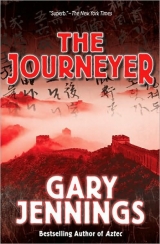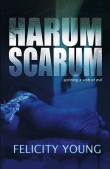
Текст книги "The Journeyer"
Автор книги: Gary Jennings
Жанр:
Исторические приключения
сообщить о нарушении
Текущая страница: 34 (всего у книги 78 страниц)
The Silk Road forks into two as it goes eastward from Kashgar. This is because there is a desert directly to the east of the city, a dry, peeling, curling desert, like a plain of shattered yellow pottery, a desert as big as a nation, and just the name of it gives good reason to avoid it, for its name is Takla Makan, meaning “once in, never out.” So a traveler on the Silk Road can choose the branch which loops northeasterly around that desert or the one looping southeast of it, which is the one we took. The road led us from one to the next of a chain of habitable oases and small farm villages, about a day’s journey apart. Always off to our left were the lion-tawny sands of the Takla Makan and, to our right, the snow-topped Kun-lun mountain range, beyond which, to the south, lies the high land of To-Bhot.
Although we were skirting clear of the desert, along its pleasantly verdant and well-watered rimlands, this was high summertime, so we had to endure a lot of desert weather that edged over from it. The only really tolerable days were those on which a wind blew down from the snowy mountains. Most frequently the days were windless, but not still, for on those days the nearness of the smoldering desert made the air about us seem to tremble. The sun might have been a blunt instrument, a brass bludgeon, beating on the air so that it rang shrill with heat. And when occasionally there came a wind from the desert, it brought the desert with it. The Takla Makan then stood on end—making moving towers of pale-yellow dust, and those towers gradually turned brown, getting darker and heavier until they toppled over onto us, turning high noon to an oppressive dusk, seething viciously and stinging the skin like a beating with twig brooms.
That dun-colored dust of the lion-colored Takla Makan is known everywhere in Kithai, even by untraveled people who have no least suspicion of the desert’s existence. The dust rustles through the streets of Khanbalik, thousands of li away, and powders the flowers in the gardens of Xan-du, farther yet, and scums the lake waters of Hang-zho, farther yet, and is cursed by the tidy housekeepers of every other Kithai city I ever was in. And once, when I sailed in a ship far upon the Sea of Kithai, not just out of touch but out of sight of the shore, I found that same dust sifting down upon the deck. A visitor to Kithai might later lose his memory of everything else he saw and experienced there, but he will forever feel the pale dun dust settling on him, never letting him forget that once he walked that lion-colored land.
The buran, as the Mongols call a dust storm of the Takla Makan, has a curious effect which I never encountered in any such storm in any other desert. While a buran was buffeting us, and for a long while after it had blown on past, it somehow made the hair of our heads stand fantastically on end, and the hairs of our beards bristle like quills, and our clothes crackle as if they had turned to stiff paper, and if we chanced to touch another person we saw a snapping spark and felt a small jolt like that from cat fur briskly rubbed.
Also, the buran’s passing, like the passing of a celestial broom, would leave the night air immaculately clean and clear. The stars came out in multitudes untellable, infinitely more of them than I ever saw elsewhere, every tiniest one as bright as a gem and the familiar bigger stars so big that they looked globular, like little moons. Meanwhile, the actual moon up there, even if it was in the phase we would ordinarily call “new”—only a fragile fingernail crescent of it lighted—was nevertheless visible in its whole roundness, a bronze full moon cradled in the new moon’s silver arms.
And on such a night, if we looked out over the Takla Makan from our camping or lodging place, we could see even stranger lights, blue ones, bobbing and dipping and twinkling over the surface of the desert, sometimes one or two, sometimes whole bevies of them. They might have been lamps or candles carried about by persons in a distant karwan camp out there, but we knew they were not. They were too blue to be flames of fire, and they winked on and off too abruptly to have been kindled by any human agency, and their presence, like that of the day’s buran, made our hair and beards stir uneasily. Besides all that, it was well-known that no human beings ever traveled or camped in the Takla Makan. Not living human beings. Not willingly.
The first time we saw the lights, I inquired of our escorts what they might be. The Mongol named Ussu said, in a hushed voice, “The beads of Heaven, Ferenghi.”
“But what makes them?”
The one named Donduk said curtly, “Be silent and listen, Ferenghi.”
I did, and, even as far from the desert as we were standing, I heard faint sighs and sobs and soughings, as if small night winds were fitfully blowing. But there was no wind.
“The azghun, Ferenghi,” Ussu explained. “The beads and the voices always come together.”
“Many an inexperienced traveler,” added Donduk, in a supercilious way, “has seen the lights and heard the cries, and thought them to be a fellow traveler in trouble, and gone seeking to help, and been lured by them away, not ever to be seen again. They are the azghun, the desert voices, and the mysterious beads of Heaven. Hence the desert’s name—once in, never out.”
I wish I could claim that I divined the cause of those manifestations, or at least a better explanation of them than wicked goblins, but I did not. I knew that the azghun and the lights occurred only after the passing of a buran, and a buran was only a mighty mass of dry sand blowing about. I wondered, did that friction have something in common with the rubbing of a cat’s fur? But out there in the desert, the sand grains had nothing to rub against except each other … .
So, baffled by that mystery, I applied my mind to a smaller but more accessible one. Why did Ussu and Donduk, though they knew all our names and had no trouble saying them, always address us Polos indiscriminately as Ferenghi? Ussu spoke the word amiably enough; he seemed to enjoy traveling with us, as a change from boring garrison duty back at Kaidu’s bok. But Donduk spoke the word distastefully, seeming to regard this journey as a nursemaid attention to us unworthy persons. I rather liked Ussu, and did not like Donduk, but they always were together, so I asked them both: why Ferenghi?
“Because you areFerenghi,” said Ussu, looking puzzled, as if I had asked a witless question.
“But you also call my father Ferenghi. And my uncle.”
“He and he is Ferenghi also,” said Ussu.
“But you call Nostril Nostril. Is that because he is a slave?”
“No,” said Donduk scornfully. “Because he is not Ferenghi.”
“Elder Brothers,” I persisted. “I am trying to find out what Ferenghi means.”
“Ferenghi means only Ferenghi,” snapped Donduk, and threw up his hands in disgust, and so did I.
But that mystery I finally didfigure out: Ferenghi was only their pronunciation of Frank. Their people must first have heard Westerners call themselves Franks eight centuries ago, in the time of the Frankish Empire, when some of the Mongols’ own ancestors, then called Bulgars and Hiung-nu, or Huns, invaded the West and gave their names to Bulgaria and Hungary. Ever since then, apparently, the Mongols have called any white Westerner a Ferenghi, no matter his real nationality. Well, it was no more inaccurate than the calling of all Mongols Mongols, though they were really of many different origins.
Ussu and Donduk told me, for instance, how their Mongol cousins the Kirghiz had come into existence. The name derived from the Mongol words kirk kiz, they said, meaning “forty virgins,” because sometime in the remote past there had existed in some remote place that many virgin females, unlikely though it might seem to us moderns, and all forty of them had got impregnated by the foam blown from an enchanted lake, and from the resultant miraculous mass birth had descended all the people now called Kirghiz. That was interesting, but I found more interesting another thing Ussu and Donduk told me about the Kirghiz. They lived in the perpetually frozen Sibir, far north of Kithai, and perforce had invented two ingenious methods of getting about those harsh lands. They would strap to the bottom of their boots bits of highly polished bone, on which they could glide far and fast upon the ice of frozen waters. Or they would similarly strap on long boards like barrel staves, to skim far and fast over the snowy wastes.
The very next farm village on our way was populated by yet another breed of Mongols. Some of the communities on that stretch of the Silk Road were peopled by Uighurs, those nationalities “allied” to the Mongols, and others were peopled by Han folk, and Ussu and Donduk had not made any comment about them. But when we came to this particular village, they told us the people were Kalmuk Mongols, and they spat the name, thus: “Kalmuk! Vakh!”– vakhbeing a Mongol noise to register sheer disgust, and the Kalmuk were disgusting, right enough. They were the filthiest human creatures I ever saw outside of India. To depict just one aspect of their filthiness, let me say this: not only did they never wash their bodies, they never even took off their clothes, day or night. When a Kalmuk’s outer garment got too worn to be serviceable, he or she did not discard it, but simply donned a new one over it, and continued wearing layers upon layers of ragged clothes until the undermost gradually rotted and shredded away from underneath, like a sort of ghastly scurf of the crotch. I will not attempt to say how they smelled.
But the name Kalmuk, I learned, is not a national or tribal designation. It is only the Mongol word meaning one who stays, or one who settles down in any place. All normal Mongols being nomads, they have a deep disdain for any of their race who ceases roaming and takes up a fixed abode. In the majority opinion, any Mongol who becomes a Kalmuk is doomed to degeneracy and depravity, and if the Kalmuk people I saw and smelled were typical, then the majority have good reason to despise them. And now I recalled having heard the Ilkhan Kaidu speak slightingly of the Khakhan Kubilai as “no better than a Kalmuk.” Vakh, I thought, if I find that he is, I shall turn around and go straight back to Venice.
However, despite my awareness that the word Mongol was a too general term for a multiplicity of peoples, I found it convenient to go on using the name. I soon realized also that the other, the original, inhabitants of Kithai were not all Han, either. There were nationalities called Yi and Hui and Naxi and Hezhe and Miao and God knows how many others, of skin colors ranging from ivory to bronze. But, as with the Mongols, I continued to think of all those other nationalities as Han. For one reason, their languages all sounded very much alike to me. For another, every one of those races regarded every other as inferior, and so called each other by their various words meaning Dog People. For still another reason, they all called any foreigner, including me, a name even less deserved than Frank. In Han and in every other of their singsong languages and dialects, any outlander is a Barbarian.
As we rode farther and farther along the Silk Road, it became increasingly crowded with traffic—groups and trains of traveling traders like ourselves, individual farmers and herders and artisans taking their wares to market towns, Mongol families and clans and whole boks on the move. I remembered how Isidoro Priuli, our clerk of the Compagnia Polo, had remarked, just before we left Venice, that the Silk Road had been a busy thoroughfare from the most ancient times, and now I saw reason to believe him. Over the years and centuries and maybe millennia, the traffic on that road had worn it down far below the level of the surrounding terrain. In places it was a broad trench so deep that a farmer in his nearby bean patch might see no more of the passing processions than the flick of a cart driver’s upraised whip. And down inside that trench, the cartwheels’ ruts had worn so deep that every cart now had to go where the ruts went. A carter never had to worry about his vehicle’s overturning, but neither could he pull it to one side when he needed to relieve himself. To change direction on the road—say, to turn off to some side-village destination—a driver had to keep going until he came to a junction where there were diverging ruts in which to set his wheels.
The carts used in that region of Kithai were of a peculiar type. They had immensely big wheels with knobbed rims, standing so high that they often reached above the wooden or canvas cart roof. Perhaps the wheels had had to be built bigger and bigger over the years just so their axles would clear the hump of ground between the road ruts. Each such wagon also had an awning projecting from its top front, to cover the driver from inclement weather, and that awning was considerately extended on poles far enough so that it also sheltered the team of horses, oxen or asses pulling the wagon.
I had heard much about the cleverness and inventiveness and ingenuity of the inhabitants of Kithai, but I now had cause to wonder if those qualities might be overrated. Very well, every cart had an awning to shelter its draft animals as well as its driver, and maybe that was a clever invention. But every wagon also had to carry several sets of spare axles for its wheels. That was because every separate province of Kithai has its own idea of how far apart a cart’s wheels should be, and of course its local wagons have long ago put the roads’ ruts that far apart. So the distance between the ruts is wide, for example, on the stretch of Silk Road that goes through Sin-kiang, but narrow on the road through the province of Tsing-hai, wide again but not quite so wide in Ho-nan, and so on. A carter traversing any considerable length of the Silk Road must stop every so often, laboriously take the wheels and axles off his wagon, put on axles of a different breadth and replace the wheels.
Every draft animal wore a bag slung under its tail by a webbing around its hindquarters, to collect its droppings while on the move. That was not to keep the road clean or to spare annoyance to people coming along behind. We were by now out of the region where the earth was full of burnable kara rock, free for the taking, so every carter carefully hoarded his animals’ dung to fuel the camp fire on which he would prepare his mutton and miàn and cha.
We saw many herds of sheep being driven to market or to pasture, and the sheep too wore peculiar backside appendages. The sheep were of the fat-tailed breed, and that breed is to be seen all over the East, but I had never seen any so fat-tailed as these. A sheep’s clublike tail might weigh ten or twelve pounds, nearly a tenth of its whole body weight. It was a genuine burden to the creature, and also that tail is considered the best part of the animal for eating. So each sheep had a light rope harness to drag a little plank behind it, and on that trailing shelf its tail rode safe from being bruised or unnecessarily dirtied. We saw also many herds of swine being driven, and it seemed to me that they could have used some expenditure of inventiveness, too. The pigs of Kithai are also a distinctive breed, being long in the body and ludicrously swaybacked, so that their bellies actually drag the ground, and I wondered why their herders had not considerately provided something like belly wheels.
Our escorts Ussu and Donduk were contemptuous of the wheeled vehicles and slow-plodding herds on the road. They were Mongols, and they thought all rights of way should be reserved to horseback riders. They grumbled that the Khakhan Kubilai had not yet kept a promise he had made some time ago: to level every least obstruction on every plain in Kithai, so that a horseman could canter across the entire country, even in darkest night, and never fear his horse’s stumbling. They were naturally impatient of our having to lead packhorses and proceed at a sedate pace instead of galloping headlong. So they now and then found a way to enliven what to them was a boring journey.
At one of our night stops, when we camped by the road instead of pushing on to a karwansarai, Ussu and Donduk bought from a nearby camp of drovers one of their fat-tailed sheep and some doughy ewe cheese. (I should probably say they procuredthose things, for I doubt that they paid anything to the Han shepherds.) Donduk unslung his battle-ax, sliced away the sheep’s tail-drag harness and in almost the same single motion cut off the animal’s head. He and Ussu sprang onto their horses, and one of them reached down to catch up by the club tail the sheep’s still-twitching and blood-spouting carcass, and the two riders began a gleefully galloping game of bous-kashia. They thundered back and forth between our camp and that of the sheepherders, wrenching the trophy animal from one another, slinging it about, dropping it frequently, trampling over it. Which of them won the game, or how they could tell, I do not know, but they tired at last and flung down at our feet the limp and gory thing, all covered with dust and dead leaves.
“Tonight’s meal,” said Ussu. “Good and tender now, uu?”
Somewhat to my surprise, he and Donduk volunteered to do the skinning and butchering and cooking themselves. It seems that Mongol men do not mind doing woman’s work when there are no women about to do it. The meal they made was one to remember, but not with bon-gusto. They began by retrieving the sheep’s lopped-off head, and it was spitted with the rest of the animal over our fire. A whole sheep should have sufficed to gorge several families of hearty eaters, but Ussu and Donduk and Nostril, with not much help from us other three, consumed that entire animal from nose to fat tail. The eating of the head was the least appetizing to watch and listen to. One of the gourmands would slice off a cheek from it, another an ear, the other a lip, and they would dip those awful fragments in a bowl of peppered juice from the meat, and chew and slurp and slobber and swallow and belch and fart. Since Mongols consider it bad manners for men to talk while they dine, that succession of good-mannered noises was not varied until they got down to the body bones and added the sound of sucking out the marrow.
We Polos ate only the meat sliced from the sheep’s loins—well-beaten by the bous-kashia and admittedly most tender. Or we would have preferred to eat only that, but Ussu and Donduk kept carving and pressing on us the real delicacies: pieces of the tail, meaning blobs of yellow-white fat. They quivered and trembled repulsively in our fingers, but we could not in politeness refuse, so we somehow managed to gag them down, and I can still feel the way those ghastly gobbets went slimily palpitating down my gullet. After the first dreadful mouthful, I tried to clean my palate with a hearty swig of cha—and nearly strangled. Too late I discovered that Ussu, after brewing the cha leaves with boiling water, had not stopped there as civilized cooks do, but had melted into the drink chunks of mutton fat and ewe cheese. That Mongol-style cha would make a nourishing full meal all by itself, I suppose, but I must say that it was downright revolting.
We ate other meals on the Silk Road that are more pleasant to recall. This far into the interior of Kithai, the Han and Uighur karwansarai landlords did not limit their fare to only the things a Muslim can eat, so we found a good diversity of meats—including that of the illik, which is a tiny roe deer that barks like a dog, and of a lovelily golden-feathered pheasant, and steaks cut from yaks, and even the meat of black bears and brown bears, which abound here. When we camped in the open, Uncle Mafio and the two Mongols vied at providing game for the pot: ducks and geese and rabbits and once a desert qazèl, but more usually they sought ground squirrels to shoot, because those little creatures thoughtfully provide the fuel for their own cooking. A hunter knows that, when he has no kara or wood or dried dung to make a fire with, he has only to look for the ground squirrels and their holes; even in a desert barren, they somehow contrive to put a weather-protective dome over their holes, of laced twigs and grass, well dried for the burning.
There were many other wild creatures in that region, not for eating but interesting to observe. There were black vultures with wings so broad that a man would have to take three paces to walk from tip to tip; and a snake so much resembling yellow metal that I would have sworn it was made of molten gold, but, having been informed that it was deadly venomous, I never touched one to find out. There was a little animal called a yerbò, like a mouse but with extravagantly long hind legs and tail, upon which three appendages it hopped about upright; and a magnificently beautiful wild cat called a palang, which I once saw making a meal of a wild ass it had downed, and which was like the heraldic pard, only not yellow of coat, but silvery gray with black rosettes spotted all over it.
The Mongols taught me to pick various wild plants as vegetable dishes for our meals—wild onions, for example, which go so well with any venison meat. There was a growth that they called the hair plant, and it did look exactly like a shock of black human hair. Neither its name nor its appearance was very appetizing, but when boiled and seasoned with a bit of vinegar, it made a delicate pickle condiment. Another oddity was what they called the vegetable lamb; they averred that it was indeed a mongrel creature bred from a mating of animal and plant, and said they preferred eating it to eating real lamb. It was tasty enough, but it was really only the woolly rootstalk of a certain fern.
The one ravishingly delicious novelty I found on that stage of the journey was the wonderful melon called the hami. Even the method of its growing was a novelty. When the vines started forming their fruit buds, the melon farmers paved over the whole field with slabs of slate for the vines to lie on. Instead of the melons’ getting sunshine only on their upper sides, those slates reflected the sun’s heat so that the hami ripened evenly all the way around. The hami had flesh of a pale greenish-white, so crisp that it crackled when bitten, dripping with juice, of a cool and refreshing flavor, not cloying but justthe right sweetness. The hami had a taste and a fragrance different from all other fruits, and was almost as good when dried into flakes for travel rations, and has never been surpassed in my experience by any other garden sweet.
When we had been traveling for two or three weeks, the Silk Road abruptly turned northward for a little way, the only time it touched the Takla Makan, making a very short traverse across that desert’s eastern-most edge, then turning directly east again toward a town named Dun-huang. That northward jink of the road took us through a pass that twined among some low mountains—really they were extremely high sand dunes—called the Flame Hills.
There is a legend to account for every place-name in Kithai, and according to legend these hills once were lushly forested and green, until they were set afire by some malicious kwei, or demons. A monkey god came along and kindly blew out the flames, but there was nothing left except these mountainous heaps of sand, still glowing like embers. That is the legend. I am more inclined to think that the Flame Hills are so called because their sands are a sort of burnt ocher color, and are windswept into flame-shaped furrows and wrinkles, and they perpetually shimmer behind a curtain of hot air, and—especially at sunset—they do glow a truly fiery red-orange color. But the most curious thing about them was a nest of four eggs which Ussu and Donkuk uncovered from the sand at the base of one of the dunes. I would have thought the objects were only large stones, perfectly oval and smooth and about the size of hami melons, but Donduk insisted:
“These are the abandoned eggs of a giant rukh bird. Such nests can be found all along the Flame Hills here.”
When I held one, I realized that it was indeed too light for a stone of that size. And when I examined it, I saw that it did have a porous surface, exactly as do the eggs of hens or ducks or any other bird. These were eggs, all right, and far bigger even than those of the camel-bird, which I had seen in Persian markets. I wondered what kind of a for-tagiona these would make if I broke them and scrambled them and fried them for our evening meal.
“These Flame Hills,” said Ussu, “must have been the rukh’s favored nesting place in times past, Ferenghi, do you not think so, uu?”
“Times very long past,” I suggested, for I had just tried to crack one of the eggs. Although it was not of stonelike weight, it had long ago aged and petrified to stonelike solidity. So the things were both uneatable and unhatchable, and they were too unwieldy for me to carry one off for a memento. They were most certainly eggs, and of a size that could have been laid only by a monster bird, but whether in truth that bird had been a rukh, I cannot say.
5
DUN-HUANG was a thriving trade town, about as big and as populous as Kashgar, sitting in a sandy basin ringed by camel-colored rock cliffs. But where Kashgar’s inns had catered to Muslim travelers, those of Dun-huang made special provision for the tastes and customs of Buddhists. This was because the town had been founded, some nine hundred years ago, when a traveling trader of the Buddhist faith was beset, somewhere on the Silk Road hereabout, by bandits or the azghun voices or a kwei demon or something, and was somehow miraculously saved from those malign clutches. So he paused here to give thanks to the Buddha, and he did that by making a statue of that deity and placing it in a niche in one of the cliffs. In the nine centuries since, every other Buddhist traveler on the Silk Road has added an adornment to another of those caves. And now the name of Dun-huang, though it really means only Yellow Cliffs, is sometimes translated as the Caves of the Thousand Buddhas.
The designation is too modest. I would call these the Caves of the Million Buddhas, at the very least. For there are now some hundreds of caves pocking the cliffs, some natural, some hewn out by hand, and in them are perhaps two thousand statues of the Buddha, large and small, but on the cave walls are painted frescoes displaying at least a thousand times that many images of the Buddha, not to mention lesser divinities and worthies of the Buddha’s retinue. I could discern that most of the images were male, and some just as clearly female, but a goodly number were indistinct as to sex. However, all had one feature in common: they all had tremendously elongated ears with lobes dangling to their shoulders.
“It is a common belief,” said the old Han caretaker, “that a person born with large ears and well-defined earlobes is destined for good fortune. Since the most fortunate of all humans were the Buddha and his disciples, we assume that they had such ears, and we depict them so.”
That aged ubashi, or monk, was pleased to conduct me on a tour of the caves, and he spoke Farsi for the occasion. I followed him from niche to cavern to grotto, and in all of them were statues of the Buddha, standing or lying peacefully asleep or, most often, sitting cross-legged on a giant lotus blossom. The monk told me that Buddha is an ancient Indian word meaning the Enlightened One, and that the Buddha had been a Prince of India before his apotheosis. So I might have expected the statues to be all of a black and runty man, but they were not. Buddhism long ago spread from India to other nations, and evidently every devout traveler who paid to put up a statue or a painting had envisioned the Buddha as looking like him.Some of the older images were indeed dark and scrawny like Hindus, but others could have been Alexandrine Apollos or hawklike Persians or leathery Mongols, and the most recently done all had unlined faces with waxy complexions and placid expressions and slanted slit eyes; that is to say, they were pure Han.
It was also evident that, in the past, Muslim marauders had often swept through Dun-huang, for many of the statues were in ruins, hacked apart, revealing their simple construction of gesso molded onto cane and reed armatures, or at the least were cruelly disfigured. As I have told, the Muslims detest any portrayal of a living being. So here, when they had not had time to destroy a statue utterly, they had chopped the head off it (the head being the abode of life) or, in even more haste, they had been satisfied to gouge out the eyes from it (the eyes being the expression of life). The Muslims had taken the trouble to scratch out even the tiny eyes of many thousands of miniature painted images on the walls—even those of delicate and pretty female figures.
“And the females,” said the old monk mournfully, “are not even divinities at all.” He pointed to one lively little figure. “She is a Devatas, one of the celestial dancing girls who entertain the blessed souls in the Sukhavati, the Pure Land between lives. And this one”—he pointed to a girl who was painted in the act of flying, in a swallowlike swirl of skirts and veils—“she is an Apsaras, one of the celestial temptresses.”
“There are temptresses in the Buddhist Heaven?” I asked, intrigued.
He sniffed and said, “Only to prevent an overcrowding of the Pure Land.”
“Indeed? How?”
“The Apsarases have the duty of seducing holy men here on earth, so their souls get damned to the Awful Land of Naraka between lives, instead of the blissful Sukhavati.”
“Ah,” said I, to show that I comprehended. “An Apsaras is a sùccubo.”
Buddhism has certain other parallels to our True Faith. Its devotees are adjured not to kill, not to tell untruths, not to take what is not given, not to indulge in sexual misbehavior. But in other respects, it is very different from Christianity. Buddhists are also adjured not to drink intoxicants, not to eat after the noon hour, not to attend entertainments, not to wear bodily adornments, not to sleep or even rest on a comfortable mattress. The religion does have the equivalents of our monks and nuns and priests, called ubashi and ubashanza and lamas, and Buddha enjoined them to live lives of poverty, as ours also are admonished, but few of them comply.








